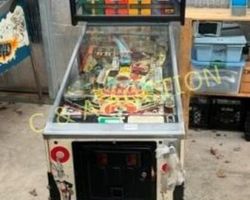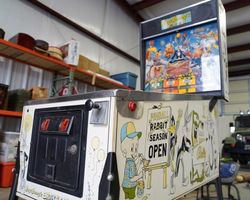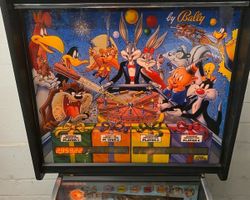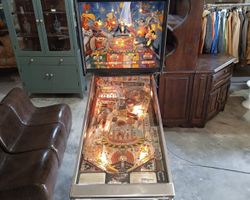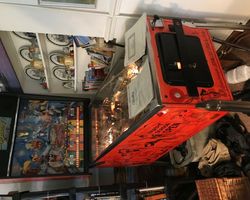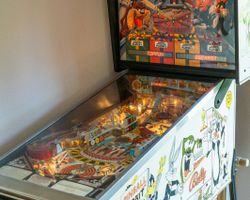Bugs Bunny's Birthday Ball
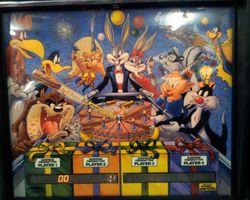
Average Prices: USD $700 to $2,500
Produced: December, 1990
Production Run: 2,500 units
Machine Type: Solid State Electronic
MPU: Williams System 11C
Players: 4
Concept by: John Trudeau, Python Anghelo
Design by: John Trudeau
Art by: Python Anghelo
Mechanics by: Jack Skalon
Music by: Paul Heitsch
Sound by: Paul Heitsch
Software by: Dan Lee, Dwight Sullivan
Bugs Bunny's Birthday Ball, a solid-state electronic pinball machine released by Bally Manufacturing Co. in December 1990, stands as a notable entry in the System 11C era. This machine tapped into the enduring appeal of the Looney Tunes universe, leveraging the beloved characters and their whimsical antics for its theme. The concept aimed to deliver a playful and accessible pinball experience, celebrating Bugs Bunny with a "birthday ball" premise.
The machine's creation involved a team of designers and artists who brought the Looney Tunes world to life on the pinball playfield. John Trudeau was the primary designer, responsible for the game's overall layout and flow. Trudeau, known for his prolific output, earned the moniker "Doctor Flash" during this period, a testament to his rapid and efficient design process, particularly as he worked on multiple titles concurrently with artist Python Anghelo. Anghelo himself contributed to the machine's concept and artwork, laying the groundwork for its visual identity. John Youssi stepped in to add color to Anghelo's initial black and white backglass art, ensuring a vibrant and appealing aesthetic. The software development was handled by Dan Lee and Dwight Sullivan, crafting the game's rules and modes. Paul Heitsch composed the custom music and sound effects, vital for reinforcing the Looney Tunes theme with authentic character voices and classic sound bites. Jack Skalon was responsible for the mechanical engineering, translating the design concepts into functional playfield elements. Approximately 2,250 units of Bugs Bunny's Birthday Ball were produced, a moderate production run for its time, suggesting Bally's expectations for a broad market appeal.
Signature Features and Design
Bugs Bunny's Birthday Ball distinguishes itself through several unique features and a highly recognizable visual presentation. The most immediate draw is the comprehensive integration of the Looney Tunes theme. The backglass, cabinet, and playfield artwork are adorned with familiar characters such as Bugs Bunny, Daffy Duck, Elmer Fudd, Sylvester the Cat, and Tweety Bird, all rendered in a faithful artistic style. The cabinet itself exhibited a distinctive visual evolution, with prototype games featuring a limited black, white, and red color scheme, while production cabinets burst forth with a broader spectrum of hues, enhancing the overall celebratory feel.
A distinctive design element that immediately captures attention is the pair of flippers shaped like carrots, a direct nod to Bugs Bunny's signature snack. This whimsical touch, while seemingly minor, contributes significantly to the machine's thematic immersion and adds a playful eccentricity to the gameplay. Another prominent feature, central to the machine's identity, is the custom speech package. Paul Heitsch's sound design includes numerous recognizable voice clips and sound effects from the Looney Tunes cartoons, which are strategically triggered throughout gameplay. This auditory feedback, combined with original musical compositions, creates a lively and engaging atmosphere, pulling players deeper into the animated world.
Perhaps the most discussed and singular mechanical feature is the upper-left, small, inverted mini-playfield. This multi-leveled design houses a dedicated flipper that propels the ball downfield, allowing it to loop around a ramp and strike a captive ball. This unusual setup was an ambitious attempt to innovate within the confines of a traditional playfield layout, aiming to provide a distinct sub-game or unique shot opportunity. While its execution and functional impact on overall gameplay were subjects of varied opinion, it undeniably serves as a defining characteristic of Bugs Bunny's Birthday Ball, setting it apart visually and mechanically from other machines of its era. The machine also includes a left outlane kickback, offering players a second chance to return the ball to the playfield after an outlane drain, adding an element of forgiveness and extending ball times.
Playfield and Mechanics
The playfield of Bugs Bunny's Birthday Ball presents a layout designed to embody the energetic and often chaotic spirit of the Looney Tunes cartoons. The main playfield features three flippers, three pop bumpers, and three slingshots that contribute to dynamic ball movement. Nineteen standup targets are scattered across the playfield, providing numerous opportunities for players to hit various character-themed targets and advance objectives. A three-bank drop target setup offers a classic pinball challenge, requiring precise shots to clear. Other interactive elements include a kick-out hole, a spinning target, and a captive ball on the main playfield, all integrated to provide varied shot opportunities and scoring potential.
A significant portion of the upper-left area of the main playfield is dedicated to the unique multi-leveled, inverted mini-playfield. This distinct area is designed to engage players with a unique shot scenario. A dedicated flipper within this inverted section allows players to propel the ball into a loop, which then feeds into a shot at a captive ball. The design philosophy behind this area was to introduce a novel mechanical interaction, offering a break from the standard playfield flow and providing a specialized objective.
The overall artwork and lighting on the playfield are vibrant and true to the Looney Tunes aesthetic. The main characters are prominently featured in various poses and scenarios, guiding the player's eye and reinforcing the theme. The playfield is bathed in colorful inserts and general illumination, designed to highlight shot targets and status indicators. While the theme's execution through art is generally considered a strong point, the actual playfield layout, with its unique features, dictates the flow. The arrangement of targets, ramps, and the large inverted playfield section can create a distinct playing experience, where shots may feel constrained or less fluid than in other designs. The two main ramps provide clear shot pathways for players to aim for repeatable scoring and progression.
Gameplay Dynamics
Bugs Bunny's Birthday Ball’s gameplay dynamics are characterized by its blend of straightforward objectives and unique scoring elements, reflecting a design ethos that aimed for accessibility alongside novelty. The progression often involves hitting various targets and ramps to activate character-specific animations and sound bites, propelling the "birthday ball" narrative. The scoring system incorporates a mix of individual target values and larger point bonuses for completing specific sequences or modes.
One of the more discussed aspects of the scoring system is the "50 million shot." This high-value shot, while offering a significant points boost, sometimes leads to an "anarchic" feel in scoring, where a single successful execution can heavily influence a player's score regardless of other playfield achievements. This element can make the game appealing for new players seeking immediate, high-reward shots, but less so for those who prefer a more layered, skill-based scoring progression.
The game features several objectives designed to distinguish it. For instance, in multi-player operation, a unique playfield award feature allows for the exchange of scores between players, adding an unexpected competitive dynamic. While specific "modes" in the contemporary sense might be limited, the game progresses through distinct phases that unlock opportunities for higher scoring and more elaborate animations. Players are encouraged to hit the various standup targets, clear the drop target bank, and make shots up the ramps to advance through the game's objectives. The upper left mini-playfield, with its dedicated flipper and captive ball, presents a distinct sub-objective, requiring players to master this unique shot to fully capitalize on its scoring potential.
Player strategies often revolve around repeatedly hitting the ramps and specific targets to accumulate points and reach the higher-value shots. While some players find the game's depth limited, leading to a repetitive experience, others appreciate its straightforward nature and thematic appeal. The game’s design emphasizes immediate gratification through sound and visual feedback, making it a potentially engaging experience for those seeking a lighter, more character-driven pinball session.
Reception and Legacy
Bugs Bunny's Birthday Ball elicited a varied reception within the pinball community following its release. Enthusiasts and collectors often discuss its strengths and weaknesses with considerable detail. On the positive side, the integration of the Looney Tunes theme consistently garners praise. The colorful and faithful artwork across the backglass, cabinet, and playfield, combined with the instantly recognizable sound effects and character voices, is widely considered a success. Many players appreciate the unique flourishes, such as the carrot-shaped flippers and the bold attempt at an inverted mini-playfield, recognizing these as efforts to introduce novelty and charm. For casual players, and particularly families with children, the machine's theme and accessible gameplay can be quite engaging, serving as a gateway into the hobby.
However, the machine also received substantial criticism, primarily centered on its playfield layout and the resulting gameplay experience. Many players describe the playfield as cluttered and limiting, suggesting that it offers a constrained number of distinct and flowing shots. This perceived lack of open space and clear shot lines can lead to repetition and a feeling of stagnation during gameplay. The upper-left mini-playfield, while unique, is often cited as a missed opportunity or a "waste of space" by some, with its functionality not fully integrating into a cohesive game flow or providing sufficient depth. The gameplay itself is sometimes characterized as shallow and unengaging, with the emphasis on certain high-value shots, like the 50 million award, creating an imbalance in scoring progression that some find to be "anarchic" rather than strategic. The overall sentiment from a segment of the community is that the game felt rushed, lacking the polish and complexity found in other titles of the System 11C era.
Despite the divided opinions, Bugs Bunny's Birthday Ball holds a distinct place in pinball history as a licensed theme from the early 1990s. Its production numbers, while not massive, ensured its presence in arcades and on location. Its legacy is perhaps less about revolutionizing pinball design and more about its unique thematic execution and experimental features. It stands as an example of Bally's efforts to leverage popular intellectual property and innovate with playfield mechanics, even if the execution sometimes resulted in polarising gameplay experiences. The machine remains a point of discussion for its ambition and its role in the evolution of licensed pinball themes during a transitional period for the industry.
Sponsored Links
 Ebay Listings
Ebay Listings
 Auction Results
Auction Results
| Cost | Location | Date |
|---|---|---|
| EUR €2,800 |  Baden-Württemberg, Germany Baden-Württemberg, Germany |
17 October, 2024 |
| EUR €4,000 |  Italy Italy |
08 April, 2024 |
| USD $2,700 |  Virginia, United States Virginia, United States |
03 June, 2023 |
| USD $5,100 |  California, United States California, United States |
24 April, 2022 |
| USD $5,495 |  California, United States California, United States |
24 April, 2022 |
| USD $3,600 |  Tennessee, United States Tennessee, United States |
23 April, 2022 |
| EUR €1,937 |  Hessen, Germany Hessen, Germany |
11 April, 2022 |
| GBP £1,420 |  Cardiff, United Kingdom Cardiff, United Kingdom |
11 April, 2022 |
| USD $6,750 |  California, United States California, United States |
31 January, 2022 |
| AUD $4,000 |  South Australia, Australia South Australia, Australia |
30 August, 2021 |


Private Policy · Search Website · Contact Us
As an eBay Partner, we may earn a commission from qualifying purchases made through links on this site, at no additional cost to you.
All trademarks and copyrighted materials remain property of their respective owners. All other content copyright 2007 - 2025 Pinpedia.

